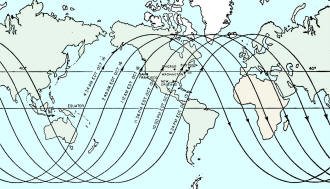|
Interestingly, the February
1958 article in Radio & TV News magazine entitled "Report on the Soviet Earth
Satellite" never mentions the craft's name - "Sputnik 1," or "Простейший Спутник-1," which
in English is "Elementary Satellite 1." Sputnik 1 was, in case your history
is a bit fuzzy, the world's first successful artificial communications satellite.
Launched by the Union of Soviet Socialist Republics (USSR) on October 4, 1957,
Sputnik 1 remained operational for about three weeks in low Earth orbit (284 miles
average), during which time radio receiving stations across the globe anxious
tuned in hoping to hear the 20.005 MHz and 40.002 MHz pulses that alternately
repeated continuously in an alternating manner - the first FSK (frequency-shift
keying) from space. Ruskie engineers made the signal frequencies and periods as
stable as possible in order to enable careful frequency and timing, combined with
time and locations of contact reports to serve indirectly as telemetry data which
once assimilated would provide orbital track, altitude, speed (Doppler shift), atmospheric
absorption and refraction effects, and other scientifically valuable information.
Amateur radio operators were encouraged to forward contact reports to Moscow, and
were rewarded with special
QSL cards (which now sell for a good price on eBay).
Report on the Soviet Earth Satellite
 Example of orbit prediction of USSR satellite
prepared by U.S. Naval Research Laboratory. Times computed for latitude 40°N;
released October 15, 1957, 11:30 a.m. Example of orbit prediction of USSR satellite
prepared by U.S. Naval Research Laboratory. Times computed for latitude 40°N;
released October 15, 1957, 11:30 a.m.
Summary of radio observations and instrumentation employed in man's first artificial
earth satellite.
The material below is based on a composite of unofficial reports on the first
USSR satellite which was launched on October 4, 1957. The information was taken
from the "IGY Bulletin", a survey by the U. S. National Committee for the International
Geophysical Year.
Instrumentation
The first announcement by Radio Moscow indicated that there were two transmitters
in the satellite, one operating at 20.005 mc. and the other at 40.002 mc. The pulse
of each signal was 0.3 sec., followed by a pause of similar length during which
the other signal was transmitted. On Oct. 8 the signals were not received for several
hours. Later, signals resumed but became continuous. The transmitter power was specified
to be 1 watt. U. S. monitors agreed that the signals were modulated with telemetry
data. Appropriate instruments within the satellite reported on atmospheric temperature
and density. Also, information on micrometeorite bombardment was probably transmitted.
Radio Observations
First U. S. radio reception of the satellite's signals was reported by RCA Communications,
Inc. at Riverhead, L. I. The observation occurred at 8:07 p.m. EDT, October 4, the
day of the launching. At 8:15, the signal was strongest from the south. First reception
at the Naval Research Laboratory in Washington, D. C., was at 8:30 p.m. By October
6, six of ten Minitrack stations had been converted from 108 mc. - the frequency
to be used by the U. S . satellites - to 20 and 40 mc., in order to track the USSR
satellite.
Radio reception was soon general and reports of continuous monitoring were received
from Antarctic IGY stations, including the South Pole - which is in a position to
hear the satellite on virtually every passage - as well as from IGY Drifting Station
A, an ice floe located about 500 miles from the North Pole.
Reports from the Amundsen-Scott South Pole Station indicated that the satellite's
radio signals cut in abruptly but faded out gradually and that there were numerous
variations in signal strength, duration, and pulse rate.
The USSR was reported to be encouraging amateur assistance, offering special
cards to hams reporting receipt of the satellite's radio signals. Radio Moscow announced
on October 26 that the satellite's radio had used up its power and had stopped working.
On the same day, the Naval Research Laboratory reported that no signals had been
received by Minitrack stations since 5:50 p.m. EDT, October 25, and that no other
information had been relayed to NRL from other radio receiver sources since 7:10
p.m, EDT, October 25. Thus, after 3 weeks of continuous operation, space's first
radio transmitter had gone dead.
Posted January 29, 2020
|










